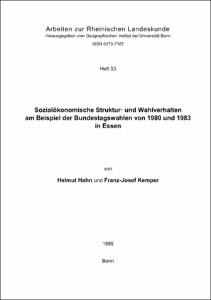Sozialökonomische Struktur- und Wahlverhalten am Beispiel der Bundestagswahlen von 1980 und 1983 in Essen

Sozialökonomische Struktur- und Wahlverhalten am Beispiel der Bundestagswahlen von 1980 und 1983 in Essen

| dc.contributor.author | Hahn, Helmut | |
| dc.contributor.author | Kemper, Franz-Josef | |
| dc.date.accessioned | 2020-10-21T13:15:28Z | |
| dc.date.available | 2020-10-21T13:15:28Z | |
| dc.date.issued | 1985 | |
| dc.identifier.uri | https://hdl.handle.net/20.500.11811/8710 | |
| dc.description.abstract | Socio-economic structure and voting behaviour.
The example of the national elections 1980 and 1983 in Essen The present exploratory study examines to which extent electoral data can be used as indicators for the socio-economic structure of an urban population. It is supposed that the spatial patterns of voting reflect the social, demographic, and religious-cultural segregation characterizing residential quarters in many German cities. For studying the continuity of such connections the two succeeding national elections for the German parliament (Bundestag) in 1980 and 1983 were selected. Both had rather different political consequences. Data were collected for Essen, one of the most important cities in the Ruhr agglomeration. The spatial structure of population and residences in Essen is marked on the one hand by distinct sectoral differences between north and south, with working-class districts in the north separated from the residential areas of the middle and upper class in the south. On the other hand, these broad sectors are filled with a mosaic of old urban and former rural cores, as well as with residential quarters of various building structures. If electoral data are useful as social indicators they should be expected to represent these complex spatial patterns. The voting behaviour was measured by the percentage of the electorate participating in the election and by the votes for the four parties with seats in the Bundestag (Social Democrats - SPD, Christian Democrats - CDU, Liberal Democrats - F.D.P., "green" alternative party - Grüne). As criteria for the social basis of voting, 43 independent variables were selected characterizing the socio-economic status, the demographic status, the religious composition, the mobility, and the housing structure of the residential quarters. Same correlation and regression analyses demonstrated that the electoral behaviour could statistically be explained by the most important variables with coefficients of determination ranging from 80 to 90 %. Although social status shows the strongest connections with party support, family status andreligious structure, including the percentage of persons without church-membership, showed significant effects as well. The level of voter turnout, which itself is regarded as an indicator of stability and social integration of a district, is particularly related to population mobility, marital status, and social status. In interpreting the results, ecological fallacies had tobe avoided. The literature about spatial voting behaviour often has postulated a neighbourhood effect leading to a strengthening of party support in homogeneous contexts. In continuation of this approach, the city was divided into 5 relatively homogeneous types of social areas by a cluster analysis. Correlation and regression analyses were computed separately for each type. The results showed on the one hand the stability or instability of some connections, on the other hand also clear context effects were visible. So it could be demonstrated that the effect of religion on party support is much more important in working-class districts than in the residential areas of the middle class. Finally two areal classifications are compared. The first defines types of similar voting behaviour, the second is concerned with the social areas. The remarkable similarity between these classifications confirms the role of electoral data as synthetical indicators of spatial social structure. | en |
| dc.format.extent | 74 | |
| dc.language.iso | deu | |
| dc.relation.ispartofseries | Arbeiten zur Rheinischen Landeskunde ; 53 | |
| dc.rights | In Copyright | |
| dc.rights.uri | http://rightsstatements.org/vocab/InC/1.0/ | |
| dc.subject | Essen | |
| dc.subject | Bundestagswahl | |
| dc.subject | Sozialstruktur | |
| dc.subject | Wahlverhalten | |
| dc.subject | Geschichte 1980-1983 | |
| dc.subject.ddc | 550 Geowissenschaften | |
| dc.subject.ddc | 914.3 Geografie, Reisen (Deutschland) | |
| dc.subject.ddc | 943 Geschichte Deutschlands | |
| dc.title | Sozialökonomische Struktur- und Wahlverhalten am Beispiel der Bundestagswahlen von 1980 und 1983 in Essen | |
| dc.type | Buch, Monografie | |
| dc.publisher.name | Dümmler Verlag | |
| dc.publisher.location | Bonn | |
| dc.rights.accessRights | openAccess | |
| dc.relation.pissn | 0373-7187 | |
| dc.relation.pisbn | 3-427-71531-0 | |
| ulbbn.pubtype | Zweitveröffentlichung |




